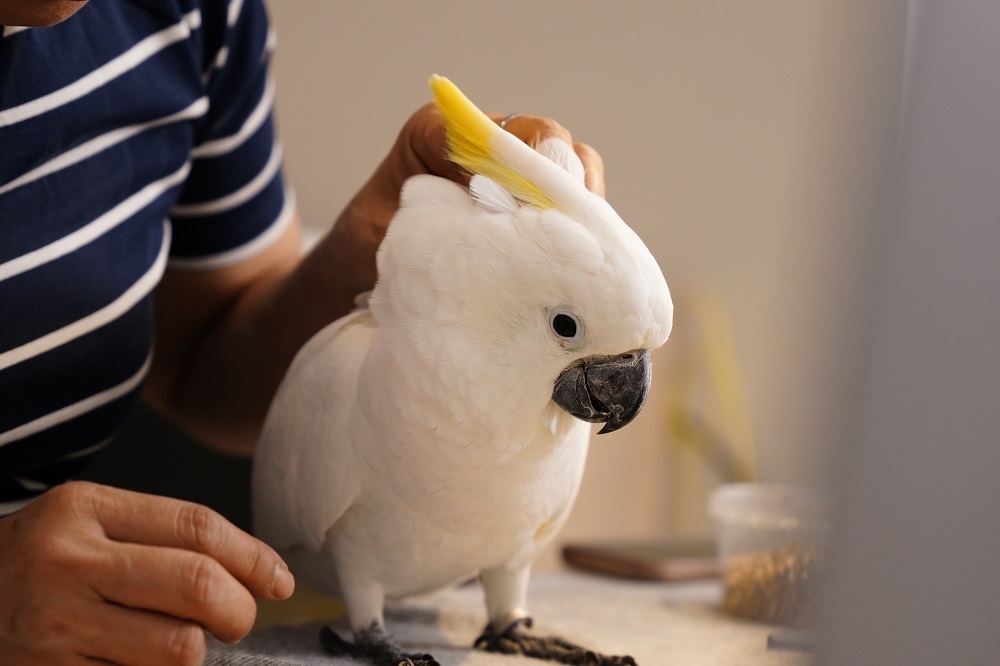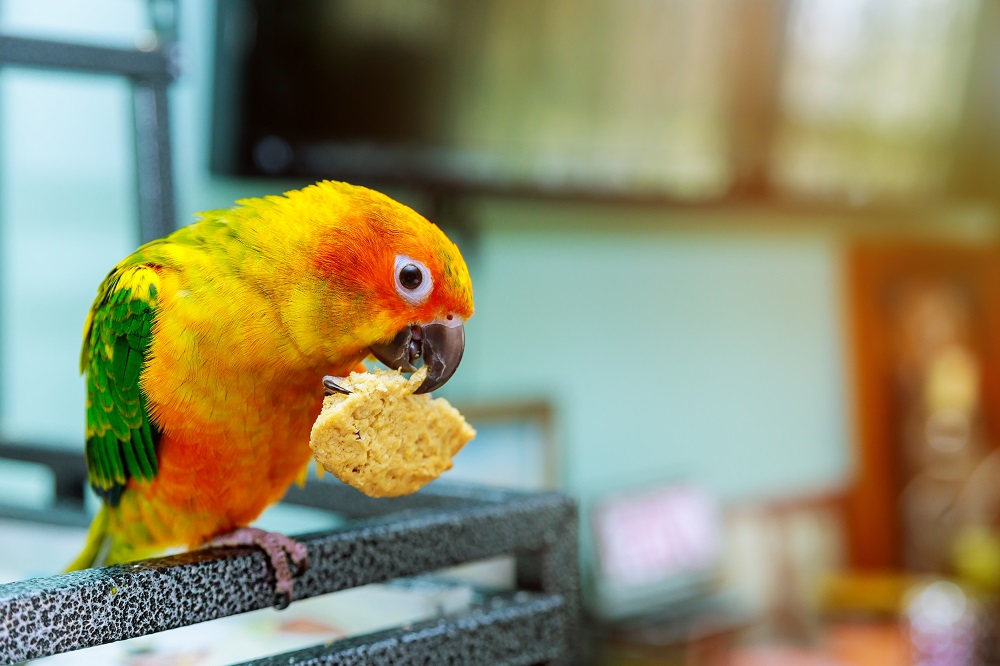Check out these 6 adorable parrots that you can have as pets. It will be love at first sight!
Even though dogs and cats have conquered everyone’s hearts, parrots are sweet and smart and can also be incredible pets. The world has more than 350 species of parrots, and they come in many sizes. However, only about 20 species can be kept as pets. This is because not all parrot species have been domesticated.
Many parrots are loving and cuddly with people they trust; they are intelligent and enjoy interacting with people. If you’re thinking about getting a pet but you don’t have the space or time for a cat or a dog, these incredible parrots that you can have as pets are going to win your heart.
Spoiler alert: They’re all adorable; you won’t know which one to choose! To help new parrot owners, we’ve put together some care guidelines.

Cockatoo
Cockatoos, also referred to as velcro birds, are among the hyperactive parrots that you can have as pets. They enjoy talking to their owners and prefer to be near them at all times. In other words, they’re overly attached. Because cockatoos are playful, providing them with a range of toys will keep them interested. We do not recommend keeping them in small spaces because they are the loudest parrots.
Their size is medium, somewhere around 24 inches (maximum) and 40 ounces. Since their life expectancy is more than 50 years, it’s recommended to leave them as a legacy to a younger close relative. Furthermore, make sure you fill their cage space with plenty of toys to keep them busy throughout the day in case you’re out for many hours.
P.S. If you go for wooden toys, be ready to change them frequently, as they tend to chew on them easily!
Eclectus Parrot
Like other parrots, eclectus parrots are loving and are happiest when they receive full attention from their owners. This breed can pick up household customs and is content to participate. They can easily be trained to speak a wide range of words because they are vocal and smart. Thankfully, they don’t make as much noise as cockatoos, which might be a plus for senior owners.
Even though they’re smaller than a cockatoo (20 inches), they like to have quite a bit of space in their cage and a little bit of time to run free in the house. Make sure you place the cage in a lighted space, preferably near the windows.
The bright red beaks of female Eclectus parrots contrast with the bright green of males, which have orange tips!
Parakeet
Among the docile parrots that you can have as pets is the parakeet, also known as the budgie. It is well known that they speak more fluently than cockatoos and macaws. They can produce imaginative melodies by absorbing human speech and sounds from their surroundings. So if you leave the cage near the TV or the radio, get ready to hear your parrot trying to imitate what they’re hearing. So a couple of swears might be on the line too!
Humans and other birds are excellent companions for parakeets, but since they’re prone to depression and begin having destructive behavior (plucking their feathers), it might not be a good idea to leave them alone for a long while. Compared to other parrots on the list, the parakeet doesn’t live longer than 15–16 years.
P.S. These tiny birds love taking a bath, especially during the warm season, so you might want to prepare a bowl filled with water near their cage.
Lovebird
A lovebird’s personality is big, and, like the parakeet, for example, they can love their owner very much. Given that they are active, they will require daily access to bird-safe play areas outside of their cages. Tricks like spinning, waving, and ringing bells can be taught to them!
When neglected, lovebirds may even refuse to be touched by you because they love attention. This breed may be the parrot for you if you enjoy listening to birds sing and whistle all day long. Although they take a little more effort than other species, they are suitable for newbies. Given how much love and care they need, it is best to keep them in pairs.

Conure Parrot
Conures are well-known for their intelligence, beauty, and knack for interacting with people. These friendly birds can be trained to do tricks and are also a great family pet, especially for those who seek a long-term companion, since their life expectancy is somewhere between 15 and 30 years.
Because Conures can make ear-piercing screams when they are bored or need attention, they might not be suitable for apartments. You can provide a space for lots of play and chewable objects to keep them content.
Various people who adopted Conures say that besides being able to reproduce words and human sounds, they can also mimic doorbell and alarm clock sounds. If you want your conure to speak faster, experts advise spending at least three hours a day with it.
Food and water bowls need to be cleaned every day. Replace the substrate, bedding, and habitat liners at least once a week, or more often if there is more than one conure living in the same space.
Looking for some healthy, vet-approved food for your little parrot? Higgins Mayan Harvest Yucatan Food Mix for Cockatiels, Lovebirds, and Conures is among the best. Jam-packed with vitamins, all-natural flavors, and omega-3 for a healthy digestive system, this 3-lb pack is available on Amazon for just $15.41.
Parrotlet
If tamed and raised properly, parrotlets—the smallest birds in the parrot family (right after the parakeets)—make wonderful pets. As social birds that don’t make a lot of noise, they’re ideal for apartment-living families.
Since parrotlets are active birds, stimulation will be necessary to maintain their mental and physical activity levels. Providing toys is recommended, particularly if you are not present frequently.
Same as other parrots on the list, these tiny birds don’t require anything special, just their regular food, some apple slices to munch on, and veggies. Their life expectancy is up to 30 years, so they’re going to be a perfect companion for people who desire a long-lived pet.
Takeaways plus small advice for beginner owners
That’s it, these are the parrots that you can have as pets, I really hope you enjoyed reading my article. Now, just like I said at the beginning of the article, I will share a couple of pieces of information for all the beginner parrot owners.
When creating a suitable habitat for parrots, there are three crucial factors to consider. The larger the cage, the better for all parrots (even for parakeets, which are comparably smaller). Your parrot should be able to spread its wings without coming into contact with anything in its cage. To prevent any injuries, you should also make sure that the bar spacing is suitable for your parrot’s size.
Next, pay attention to the environment outside the cage and make it as safe as possible. Let the bird explore your room to feel as comfortable as possible. Of course, as I previously mentioned, try to keep them occupied throughout the day, buy them multiple toys, and install tiny gyms.
In case your dear parrot gets sick, it is better to call the vet. There aren’t specific meds that I can tell you about, mostly because they’re small and fragile, and regular homemade cures that work for dogs and cats might not apply to birds.
Because I have a thing for birds, I’ve put up another article related to this topic with a twist: 7 Beautiful Birds that You’ll See Only in America.












